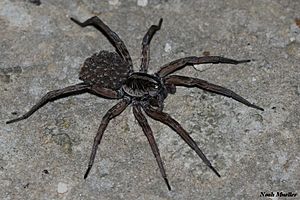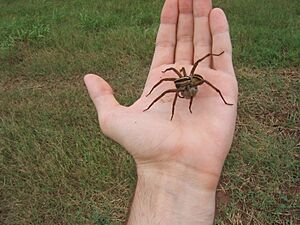Carolina wolf spider facts for kids
Quick facts for kids Carolina wolf spider |
|
|---|---|
 |
|
| Female with spiderlings on her back | |
| Scientific classification |
The Carolina wolf spider (scientific name: Hogna carolinensis) is a large spider found all over North America. It is the biggest type of wolf spider on the continent. Males are usually about 18–20 millimeters long. Females are even bigger, measuring 22–35 millimeters.
These spiders are mostly brown with darker patterns on their backs. Their undersides are dark, and male spiders can have orange on their sides. Carolina wolf spiders live in burrows, which are tunnels they dig or find. Unlike many spiders, they do not spin webs to catch food. Instead, they hunt by waiting for prey to come close to their burrow.
Female Carolina wolf spiders are special because they carry their egg sacs on their bodies. This happens while the eggs are growing inside. These spiders also have a unique venom. It helps them paralyze their prey. The venom also protects them from germs that might be on their food. Carolina wolf spiders can control their body temperature well. This helps them live in places like deserts, where temperatures change a lot.
Contents
- What is the Carolina Wolf Spider's Name?
- How to Identify a Carolina Wolf Spider
- Where Do Carolina Wolf Spiders Live?
- What Do Carolina Wolf Spiders Eat?
- Who Hunts Carolina Wolf Spiders?
- What Are Their Burrows Like?
- How Do Carolina Wolf Spiders Reproduce?
- How Do Carolina Wolf Spiders Mate?
- Do Carolina Wolf Spiders Have Social Behavior?
- Who Are Their Enemies?
- How Do Carolina Wolf Spiders Move and Sense?
- Do Carolina Wolf Spiders Bite Humans?
- Carolina Wolf Spider in Culture
What is the Carolina Wolf Spider's Name?
The Hogna carolinensis is commonly called the Carolina wolf spider. In the past, it was known as Lycosa carolinensis. But scientists changed its name in the late 1900s. They moved it to the Hogna group, along with many other spiders. This change was part of improving how living things are classified.
How to Identify a Carolina Wolf Spider
The Carolina wolf spider is the largest wolf spider in North America. Adult females can grow up to 35 millimeters. Males are a bit smaller, around 18-20 millimeters. They are light brown with darker brown patterns on their backs. Their bellies are black, and males might have orange on their sides.
There are a few ways to spot a Carolina wolf spider. The orange color on males is a good clue. Females can be identified during breeding season because they carry their egg sacs. Also, their eyes reflect light. This makes them easy to spot if you shine a light on them at night.
Where Do Carolina Wolf Spiders Live?
Where are Carolina Wolf Spiders Found?
Carolina wolf spiders live across a large part of North America. You can find them in places like South Carolina and Kansas. They also live in all the Great Lake States and the American Southwest. Most studies on these spiders have focused on those living in deserts.
What Kind of Habitat Do They Prefer?
These spiders live in many different types of places. This is because they are found all over North America. Research shows they like flat, open areas. For example, in deserts, their hunting area often stops where the land changes sharply.
What Do Carolina Wolf Spiders Eat?
What is Their Prey?
Carolina wolf spiders mostly eat insects and other small creatures without backbones. They often hunt grasshoppers and crickets. If they live near human homes, they might also eat pests like cockroaches. Scientists have even seen them eat small geckos. This shows they can catch small animals with backbones too.
How Do They Hunt?
Carolina wolf spiders do not use webs to catch food. They wait at the edge of their burrow or another good hiding spot. When prey comes close, they attack quickly. If a spider catches food away from its burrow, it will eat it there. If it's in its burrow, it drags the prey deep inside. They hold onto their food with their chelicerae, which are like their jaws.
Who Hunts Carolina Wolf Spiders?
Even though they are good hunters, Carolina wolf spiders can also become prey. Since they live in many places, they have many predators. These include different types of lizards, amphibians, wasps, and birds that eat spiders.
What Are Their Burrows Like?
Carolina wolf spiders usually live in burrows. They either dig their own or find an empty one. To dig a burrow, they first make a small hole. Then, they spin a web to hold the dirt in place. They keep digging until the burrow is big enough. They don't have special digging body parts. So, it's sometimes easier for them to take over another animal's burrow. Sometimes, young spiders even take over their mother's burrow if she dies.
Their burrows come in different sizes and shapes. Some are straight tunnels, while others have bends. Scientists think the shape depends on the easiest way to dig. The size of the burrow also often matches the size of the spider. Carolina wolf spiders also build turrets around their burrow entrances. These turrets are made of sticks, grass, leaves, pebbles, and mud. We don't know exactly why they build them. But they might be a lookout spot or an early warning system for danger. Spiders usually dig and improve their burrows early in their active season.
Burrows are more than just safe homes. They create a special microclimate for the spiders. Some burrows go as deep as 30 centimeters. This means they are about 4 degrees Celsius cooler than the ground surface. This is very important for spiders living in hot deserts.
The burrow is the main home for a Carolina wolf spider. They usually claim an area about one meter around their burrow. They don't often interact with other spiders, except for mating or raising young. So, burrows are spread out, away from other spiders' territories.
How Do Carolina Wolf Spiders Reproduce?
Reproduction
Carolina wolf spiders mate in late summer. Females carry their eggs in a sac attached to their body. The eggs hatch in about two weeks. There are usually two main times when females carry eggs: late July and late August. While carrying eggs, females are often seen "sunning" their egg sacs. This means they sit near the top of their burrow with their head down and their egg sac pointing up. Carolina wolf spiders are active at night, so this happens during nighttime hours. Scientists are not sure why they do this. But they think the warmth helps the eggs hatch faster. About 200 spiderlings hatch from each egg sac.
Life Cycle
Spiderlings (baby spiders) are born near the end of summer. They stay with their mother for about six days, unless there's a flood. During this time, they learn from their mother. They also live off the leftover yolk from their eggs. After six days, the spiderlings leave to find their own homes. As they grow, they go through several stages (called instars). They reach breeding age at about three years old. In their third summer, they will mate for the first time. Males usually die that same summer. But females can live for several breeding seasons.
Carolina wolf spiders are active from March to October. They hibernate (sleep through winter) from November to February.
How Do Carolina Wolf Spiders Mate?
Courtship
When it's time to mate, the male spider approaches the female. He starts by stretching out his front legs. Then, he wiggles his palps (small feelers near his mouth) and vibrates his body. He repeats this several times. The male then moves closer, matching the female's speed. If she moves fast, he moves fast. If she moves slowly, he does too. Once he is close, he gently pokes her with his front legs.
The female will react in one of two ways. She might fight him or not. If she fights but doesn't kill him, he will keep trying to mate. If she fights and then chases him, he will run away. If she doesn't fight and just runs away, he will follow her to continue the courtship. Sometimes, if no female is around, males might even try to court other males by mistake.
Female Interaction
Carolina wolf spiders are mostly solitary, meaning they live alone. So, females don't interact much. When female Carolina wolf spiders do meet, they often make threatening moves. They might stretch out their front legs, open their chelicerae (jaws), or tap their palps.
Do Carolina Wolf Spiders Have Social Behavior?
Carolina wolf spiders are not social animals. However, studies show that spiderlings who stay with their mother after birth learn better hunting skills. They also develop bigger brains.
Who Are Their Enemies?
Carolina wolf spiders are hunted by large insects and other creatures with exoskeletons. These include scorpions, owls, and coyotes. One scientist even saw a group of ants enter a spider's burrow, eat the spider, and then take over its home.
How Do Carolina Wolf Spiders Move and Sense?
Locomotion
Male and female Carolina wolf spiders run at about the same speed when escaping danger. However, males are much more likely to run away from a threat than females. Spiders run to get far enough away that a predator loses interest. Scientists think this is because male spiders don't own burrows as often as females. So, males can't always escape into a safe burrow. Interestingly, faster spiders tend to run farther. Both speed and distance help them avoid predators.
Senses
Carolina wolf spiders use sight and smell. They also react to vibrations they feel. If they sense vibrations, they will either go back to their burrow or run away.
Thermoregulation
Carolina wolf spiders are very good at controlling their body temperature. This is especially important for those living in deserts or places with big temperature changes. They can get used to new temperatures in about 1.5 to 3 days. They do this by increasing their oxygen use a lot, then lowering it to the right level for that temperature. This helps them avoid big changes in how much food and water they need. Before they fully adjust, they can stay cool by keeping their bodies close to water and drinking a lot. These water sources are important because Carolina wolf spiders cannot make their own water through body processes.
Do Carolina Wolf Spiders Bite Humans?
The Carolina wolf spider is venomous. But its venom is not mainly for defense against big threats like humans. Scientists believe their venom, which contains special substances called lycotoxins, is used to paralyze their prey. It also helps protect them from germs that might be on their food. Lycotoxins change how signals work in their prey, especially affecting calcium in the body, which causes paralysis. Recent research shows this venom is unique. It forms a new type of spider venom because of its special makeup and its ability to fight microbes.
Carolina Wolf Spider in Culture
In 2000, the H. carolinensis was chosen as the state spider of South Carolina. This idea first came from a third-grade student named Skyler B. Hutto.



